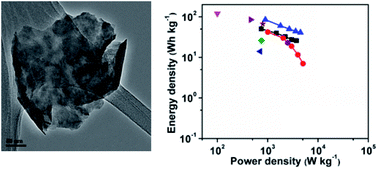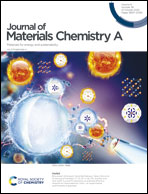Tri-rutile layered niobium-molybdates for all solid-state symmetric supercapacitors†
Abstract
Pseudocapacitive materials are considered to be promising for next-generation electrochemical capacitors due to their inherent high energy density. There are however, a number of concomitant challenges, including low ionic conductivity, and poor accessibility of the intercalation sites, which limit the viability of pseudocapacitors. Pseudocapacitive materials that address the aforementioned challenges simultaneously to enable high energy density remain scarce in the literature. Here, we report the pseudocapacitive behavior of tri-rutile two-dimensional (2D) layered niobium-molybdate (HNbMoO6) nanosheets to achieve high energy density. Owing to the unique properties of HNbMoO6 nanosheets, such as wide interlayer spacings (which offer both abundant intercalation sites and high mobility to electrolyte ions), a high level of charge-storage (670 F g−1) can be achieved. Moreover, the cage-protons (H+) that are available between the MoO6/NbO6 layers serve as a vehicle to conduct ions. A solid-state symmetric device comprising HNbMoO6 nanosheets as both the positive and negative electrode materials delivered a high energy density of about 86 W h kg−1 (43 W h L−1) and power density of ∼900 W kg−1 (450 W L−1), at an applied current density of 1 A g−1. The as-prepared device is capable of retaining about ∼70% of its initial capacitance upon 4000 cycles of continuous charge/discharge. The wide range of possibilities of tuning the electrochemical properties of the tri-rutile layered structures will propel a plethora of layered materials with high energy density as well as high power density applications.

- This article is part of the themed collection: Journal of Materials Chemistry A Emerging Investigators


 Please wait while we load your content...
Please wait while we load your content...